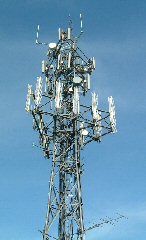


   |
A short explanation of common technical terms and abbreviations |
|||
|
Extremely low frequency pulsed electromagnetic radiation does affect living organisms. That means you and me. We are the experiment. |
Terms relating to non-ionising radiation EMF : electromagnetic field EMR : electromagnetic radiation RF : radio frequency MW : (in our context) microwave ELF : extremely low frequency (typically 1 to 300 Hz [Hertz or cycles per second]) Carrier frequency : the frequency of the microwaves that are shaped or modulated to carry information (eg 1200MHz = 1.2GHz is used by some GSM) Pulse frequency : the frequency of data bursts from TDMA systems (eg 217Hz for GSM) Frequency/wavelength
1 kHz = 1 kilo Hertz = 1,000 cycles per second 1 MHz = 1 mega Hertz = 1,000,000 cycles per second 1 GHz = 1 giga Hertz = 1,000,000,000 cycles per second examples: GSM transmits around 900 MHz = 900,000,000 cycles per second UMTS transmits around 2.1 GHz = 2,100,000,000 cycles per second therefore UMTS is a higher frequency and its wavelength is shorter. Second rule of this: the lower the frequency the more penetrative the radiation is: TETRA at 400 MHz is more likely to go through you, UMTS at 1.2 GHz is more likely to be absorbed by you. And also perhaps easier to shield yourself from. Mobile technology terms:GSM : global system for mobility (2G or 2.5G phones, where G is for generation) a TDMA system 3G : also UMTS : universal mobile telephony standard, in the UK a WCDMA system TETRA : TErrestrial TRunked RAdio, a TDMA system WiFi : wireless computer connections DECT : Digital Enhanced Cordless Telecommunications. A GSM (TDMA) standard for domestic and office wireless phones. TDMA : Time Division Multiple Access (giving users time slots in turn) CDMA : Code Division Multiple Access (giving people’s data packets codes to identify them in transit) FDMA : Frequency Division Multiple Access (giving people different carrier frequencies so they can talk at once) WDMA : Wideband Division Multiple Access (having a carrier frequency band so wide lots of people and data can be squeezed in at once on slightly different frequencies) – and combinations, like TDCMA to get even more out of systems Medical:ES : Electrosensitivity EHS : Electro-hypersensitivity MND : motor neurone disease
|
 TETRA in mast sharing. Government choice and saves planning, but with what combination effect? |
|
Home | |||